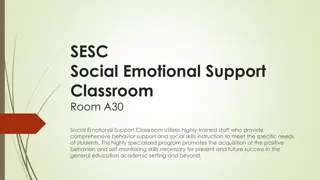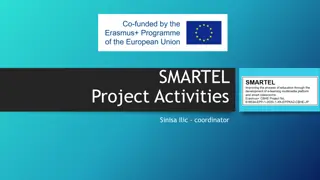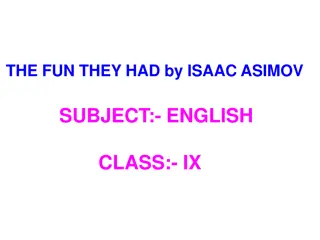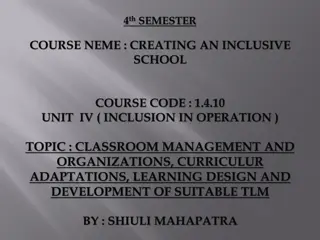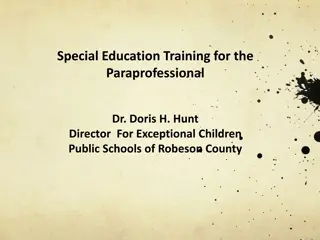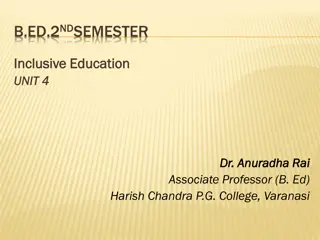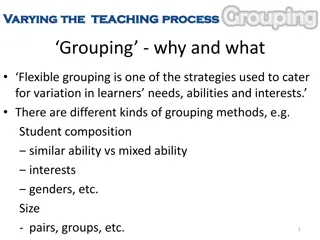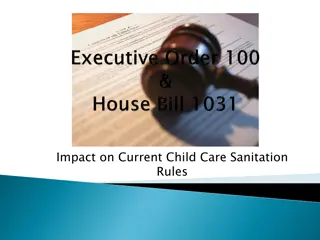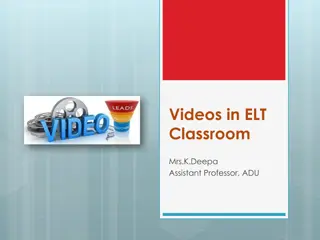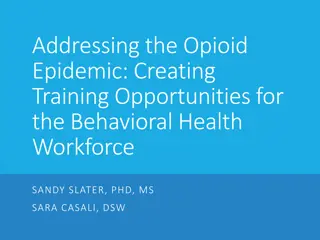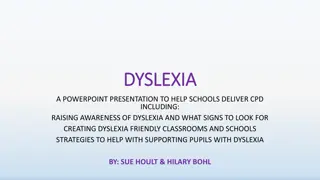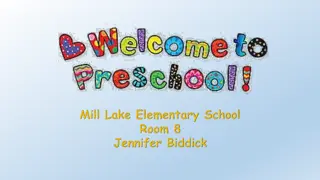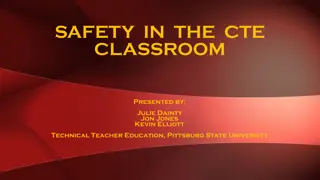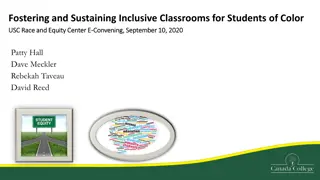Benefits of Inclusive Education for Paraprofessionals in Inclusive Classrooms
Inclusive education in classrooms provides numerous benefits, such as increased communication and collaboration among educational team members, more personalized attention for students, and quicker achievement of results through teamwork. Special education areas of exceptionality and the referral process in Georgia emphasize the importance of implementing interventions to address students' needs before considering special education services. Activities like contrasting inclusion vs. exclusion and exploring the overview of special education highlight the significance of creating a supportive and inclusive learning environment for all students.
Download Presentation

Please find below an Image/Link to download the presentation.
The content on the website is provided AS IS for your information and personal use only. It may not be sold, licensed, or shared on other websites without obtaining consent from the author. Download presentation by click this link. If you encounter any issues during the download, it is possible that the publisher has removed the file from their server.
E N D
Presentation Transcript
Paraprofessional Training ~ Support in Inclusive Classrooms November 29, 2017
If you think youre too small to make a difference, you obviously have never been in bed with a mosquito! ~Michele Walker
Overview of Special Education and Inclusion Session 1
Inclusion Vs. Exclusion Inclusion Content Happy Belonging Accepted Exclusion Lonely Misunderstood Rejected Depressed Unhappy Children who are comfortable and happy are less likely to be afraid to take the educational risks involved in learning.
Activity: Inclusion vs. Exclusion Take out a sheet of paper and pencil See handout
Benefits of Inclusive Education Communication and collaboration increase with the new educational team No longer is one person expected to meet the needs of all students in the classroom When team members collaborate, results are achieved more quickly The majority of students benefit from two adults in the classroom more students receive individualized attention
Special Education Areas of Exceptionality Autism Orthopedic Impairment Deafblind Other Health Impaired Deaf/Hard of Hearing Significant Developmental Delay Emotional Behavior Disorders Specific Learning Disability Intellectual Disabilities Mild Moderate Severe Profound Speech/Language Disorder Traumatic Brain Injury Visual Impairments and Blindness
Referral Process Georgia requires that schools implement interventions/strategies to close the achievement gap prior to referring a student for special education Response to Intervention Tier 1 General education (All students) Tier 2 General education (Some students) Tier 3 Student Support Team (Small group/targeted interventions) Tier 4 Special education (Specialized Instruction) A diagnosis/prescription for IEP does not necessitate special education
Characteristics & Classroom Implications Autism Characteristics Ranges from mild to severe Impacts communication/pragmatic language, social skills and intelligence Poor fine motor skills/awkward gait Do not read social cues Classroom Implications Need for structure and routine. They need to know, in advance, of any changes in the schedule. They are very literal, don t get humor/jokes, etc Dislike for writing They are rule follower s and get upset when others do not follow the rules Become upset in large groups too much stimulation Become upset when told no better to give them choices Don t recognize personal space of others, don t read facial expressions
Characteristics & Classroom Implications Deaf-Blindness Hearing and vision loss Loss can be mild to severe Impacts communication/language development Impacts fine and gross motor skills Several special education specialists work with the student Deafness Cannot hear, with or without amplification Severity can be mild to profound Does not impact intellectual ability Students may require a sign-language interpreter The use of an amplification system may be needed for the classroom May need assistance with note-taking, verbal directions, class lectures, etc.
Characteristics & Classroom Implications Emotional/Behavior Disorders Characteristics Difficulty learning even though student has the intellectual ability Difficulty maintaining relationships with peers and adults Over-react to situations without an explanation/reason Generally depressed or sad Get sick when faced with personal or school problems Classroom Implications Off task behavior Work avoidance Argumentative Disorganized Withdrawn/doesn t socialize with peers
Characteristics & Classroom Implications Hearing Impairment Characteristics Hearing loss that is mild to profound Documented by audiologist and ENT doctor Hearing loss can progressive or fluctuate Typically does not impact intellectual ability Classroom Implications Communication with peers/adults is impacted Sit closer to the teacher Difficulty processing spoken language/instructions Nate taking may be difficult Use of voice amplification system by the teacher Sign language interpreter may be needed
Characteristics & Classroom Implications Intellectual Disabilities Characteristics Low intellectual ability Ranges from Mild to Profound Difficulty remembering skills learned Poor self-help skills Immature social skills Classroom Implications Difficulty controlling behavior in certain situations May be withdrawn and show signs of low self-esteem Difficulty applying new skills to other situations Difficulty with reading, reading comprehension, math, vocabulary, etc. Difficulty using language to express themselves Need assistance with toileting, standing, sitting, eating
Characteristics & Classroom Implications Orthopedic Impairments Characteristics Motor impairments mild to severe Deformity or absence of some limb Cerebral Palsy, amputations, and fractures or burns that cause contractures Poliomyelitis, Osteogenesis Imperfecta, Muscular Dystrophy, Bone Tuberculosis, etc. Secondary characteristics may be communication, hearing loss, intellectual disabilities Classroom Implications Ability to walk, run, open doors, open milk cartons, eat lunch, etc. Ability to take notes, communicate with others, use restroom independently Ability to sit and/or stand independently Absences due to therapy appointments, surgeries, etc. IMPORTANT Do not assume that a student with orthopedic impairments is also intellectually disabled
Characteristics & Classroom Implications Other Health Impairments very broad category Characteristics Heart condition ADD/ADHD Asthma Epilepsy Classroom Implications Off task behavior Struggle with organization Struggle with reading, reading comprehension, math, writing, etc Struggle with note taking Frequent absences due to medical appointments
Characteristics & Classroom Implications Significant Developmental Delay Characteristics For children ages three through nine Delays in the following areas: Adaptive Behavior Cognition Communication Motor Development Emotional Development Impacts performance in age-appropriate activities Classroom (home/daycare settings/Headstart) Implications Toilet training Speaking Playing Following directions
Characteristics & Classroom Implications Specific Learning Disabilities Characteristics One or more basic psychological processes involved in understanding or using language, spoken or written, that may manifest in an imperfect ability to listen, think, speak, read, write, spell or do mathematical calculations. Perceptual ability, dyslexia and developmental aphasia (Aphasia is an impairment of language, affecting the production or comprehension of speech and the ability to read or write.) Classroom Implications Difficulty with the components of reading: Phonemic awareness, Phonics, Fluency, Vocabulary, Comprehension Difficulty with math calculation and math reasoning Difficulty copying from the board Difficulty following multi-step directions Low self-esteem
What is it like to have a Learning Disability? https://www.youtube.com/watch?v=Yxo5cpzP3zs
Characteristics & Classroom Implications Speech/Language Impairments Characteristics Stuttering Impaired articulation Language impairment Voice (hoarseness, vocal cords) Classroom Implications Difficulty expressing oneself Difficulty understanding directions or oral presentations Difficulty pronouncing words when reading, talking with peers/adults (omit sounds, produce sounds incorrectly, adding sounds) Difficulty reading fluently Withdraw from class discussion Speak loudly/softly in the classroom
Characteristics & Classroom Implications Traumatic Brain Injury Characteristics Injury to the brain from external force Total or partial functional disability that impacts education performance Classroom Implications Depends on the extent of the injury May impact all academics May impact behavior/social skills May impact communication May need support such as extra time to complete assignments, note-taker, etc May need more support such as toileting, eating, walking, etc.
Characteristics & Classroom Implications Blind/Visual Impairments Characteristics Partial sight Total blindness Classroom Implications Can t see the board May need large print books or braille May need special lighting/magnifiers May need support navigating the building (orientation and mobility) May need someone to carry books, lunch treys, etc.
Strategies to Support Students with Disabilities within the Classroom See Handout
Confidentiality and Special Education IDEA provides procedural safeguards to parents and students with disabilities, to insure that ALL information is kept confidential The information about your child being a child with a disability eligible under the IDEA, his or her special education and related services, and other personally identifiable information is confidential and is not released to others within the system unless they have a legitimate need to know nor is it released to other agencies or groups except under limited circumstances. Talking with others about students with disabilities is a violation of the rights of the parents/guardians and sets the school system and you up for liability Maintaining confidentiality is also a part of the Code of Ethics for Educators, Standard 7: Confidential Information
Confidentiality and Special Education Standard 7: Confidential Information An educator shall comply with state and federal laws and state school board policies relating to the confidentiality of student and personnel records, standardized test material and other information. Unethical conduct includes but is not limited to: 1. sharing of confidential information concerning student academic and disciplinary records, health and medical information, family status and/or income, and assessment/testing results unless disclosure is required or permitted by law; 2. sharing of confidential information restricted by state or federal law; 3. violation of confidentiality agreements related to standardized testing including copying or teaching identified test items, publishing or distributing test items or answers, discussing test items, violating local school system or state directions for the use of tests or test items, etc.; and 4. violation of other confidentiality agreements required by state or local policy.
FERPA: Family Educational Rights and Privacy Act https://www.youtube.com/watch?v=JefYWKAAn5I
Confidentiality and Special Education IEP meetings Parent information Student information Progress Lack of progress Personal information Sticky information that maybe discussed Classroom Activities Observations of teachers instructional methods Important: If you disagree with what the teacher is doing, talk with the teacher, not others! If you love what he/she is doing and want to share it with others, get permission from the general education teacher! This builds trust between you and the teacher
Confidentiality and Special Education Guidelines to follow: Discuss students with those who have a right to know. When asked about students with whom you work, the best answer is I cannot answer that question. Do not keep personal notes on students. All information should remain in a locked file cabinet at school. Do not remove student files. Do not discuss information regarding teachers, situations, students, etc. with others. Refrain from using student names when talking about your job in social settings. Use good judgement Report all suspicions of abuse/neglect immediately. Know your school s procedure for this.
The Bottom Line about Confidentiality .. Maintain confidentiality Show respect for colleagues, students and families Demonstrate dependability Operate with integrity




